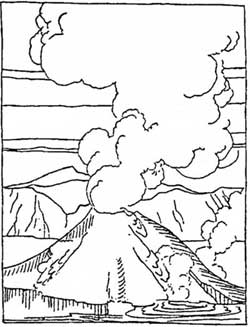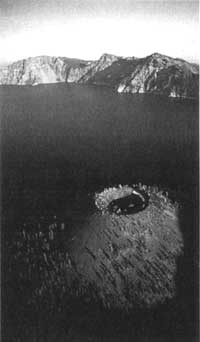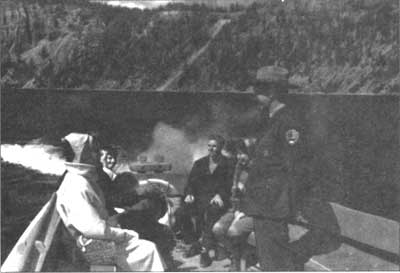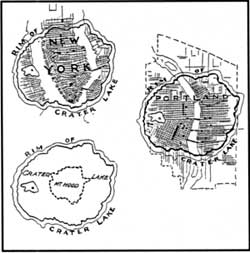Other Crater Lakes
The unusual setting of Crater Lake may suggest to observers that volcanic forces in the Pacific Northwest have created a unique landscape that is rarely, if at all, duplicated elsewhere. Without regard to the special beauty attributed to Crater Lake, there are many other examples of volcanic lakes around the world (some in the Northwest) which, like Crater Lake, have unusual physical and chemical properties that set them apart from other bodies of water.
Crater and Caldera Lakes
 Drawing by L. Howard Crawford, 1934. |
Volcanic lakes are relatively common. About 12 percent of the world’s Holocene-age volcanoes (those active over the past 10,000 years) have such lakes. Considering that stable volcanic lakes are often found in either very old or extinct craters (created more than 10,000 years ago), the total number of these types of lakes around the world must number in the hundreds. Within the immediate region surrounding Crater Lake, there are three volcanic lakes: Paulina and East Lake in Newberry Crater National Monument near La Pine, Oregon, as well as Medicine Lake, due south of Lava Beds National Monument in northern California. The distinction between lakes located in calderas as opposed to those found in true craters relates only to the size and depth of the resulting lake. Large volume volcanic lakes, with large quantities of water usually are more stable and survive longer.
Water will gather within a volcanic depression if the walls have become impermeable. This is often accomplished by the decomposition of fine volcanic materials (ash) which have been hydrochemically altered into clay. Fine particles, such as clay, can be effective in sealing the openings that appear between rocky layers. This process may begin long before a lake appears and while the parent volcano is still releasing lava. Once a depression forms, it may fill with water from a variety of sources. The water usually comes from the atmosphere (precipitation), but it can also be generated through hydrothermal activity or from groundwater that draws upon the local water table.
 Top of Wizard Island. |
Many craters are dry. The depression atop Wizard Island (the Witches Caldron) is an example. It is filled with snow all winter but the melt simply drains through the unconsolidated ejecta of this cinder cone. Other craters, initially filled with water, may lose it in a variety of ways. Repeated volcanic eruptions might eject the trapped lake water, or perhaps the water might eventually leak or boil away. Most lakes considered in this article are located in the wet tropics where precipitation levels are naturally high—so if the lake loses its water, it will eventually return.
Volcanic lakes vary in diameter (most are circular or elliptical), depth, temperature, color, chemistry (salinity and pH), and in their concentration of dissolved gasses (oxygen, carbon dioxide, and sulfur dioxide). These physical and chemical properties are directly related to the volcanic input supplied to the lake by fumerolic and hydrothermal activity. The stability of the lake, through time, is governed by the volcanic potential posed by the magma chamber, and the volume of water resting directly above these hot fluids.
Volcanic Lake Dynamics
For a body of water to remain inside the walls of a crater for some length of time, it must come into equilibrium with the volcanic forces that produced the depression. Energy is supplied to volcanic lakes by hydrothermal springs and fumerolic gas vents. The heat energy entering the lake from below must be effectively radiated away from the water surface without raising the temperature of the water beyond approximately 45°C (113°F). Smaller bodies of water having lower heat capacities are thus more easily boiled away, with time. Larger volcanic lakes can more easily absorb heat energy delivered from below and radiate it away over a bigger surface area.
No matter what volume of water accumulates within a crater, no lake can survive a major volcanic eruption. Vast amounts of water can be ejected during a volcanic vent. The presence of lake water may additionally heighten the explosive nature of the eruption. Measured over thousands of years, the vast majority of crater lakes around the world display a life-cycle which starts with water accumulation followed by period of quiet. Eruptive episodes, however, shatter these quiet times with at least the partial evacuation of water from the crater.
The chemistry of volcanic lakes can vary between pure, oxygen rich water and water that may be highly saline, acidic or alkaline, and gas rich. The latter can consist of oxygen and sulfur dioxide, or conversely, carbon dioxide. Much depends upon the nature of the hydrothermal springs and fumerolic vents feeding the lake. Recent work has permitted volcanic lakes to be classified into several distinctive groups that are based upon the degree of activity associated with the discharges occurring at the lake bottom.

Volcanic activity at Crater Lake is so miniscule that park naturalists have been giving boat tours since 1931. NPS photo by Jack Boucher, 1960.
Peak-Activity Volcanic Lakes
These lakes cannot reach a level of equilibrium, so they soon disappear. Peak-activity lakes tend to be small, hot, saline, and form corrosive pools that continuously steam and boil. Temperatures in these types of lakes are raised beyond 45°C by the injection of hot fumerolic gases somewhere at the basin. Their mass is eventually either ejected or simply just boils away. A good example of a peak activity lake is Laguna Calientes at Poas Volcano in Costa Rica. Poas has erupted 39 times since 1828 and is in a state of continuous mild activity. Between 1984 and 1990, this 140 meter lake had a temperature that fluctuated between 38°C and 96°C (100°F-205°F) Mineral concentration rose from 6 percent (by volume) to 35 percent and acidity decreases slightly from 0.26 to -0.87. During eruptions, water from the lake was ejected 500 meters into the air. In many photographs of Laguna Calientes, stream can be seen rising from the surface. The lake finally drained away in 1989 leaving an exposed pool of liquid sulfur, the first ever observed on earth.
High-Activity Volcanic Lakes
 Steel Points, 1907. |
These lakes possess relatively high salt and strong acid content. Unlike peak-activity volcanic lakes, high-activity lakes are stable with temperature less than 45°C. Those with temperatures greater than 35°C are considered hot acid-brine lakes, while those less than 35°C are labeled as cool acid-brine lakes. Yagama Lake in Japan fits both categories. Between eruptions it is a cool acid-brine lake but warms up before and after events. A shallow hot acid-brine lake has formed inside the new caldera at El Chichon, Mexico, following the 1982 eruption. The lake is blue-green in color, a consequence of its high salinity and large load of suspended ash.
The Keli Mutu volcanic lake, named “TiN” by western scientists, is an example of a cool acid-brine lake. It is one of three lakes located atop a degassing stratovolcano that straddles the equator. Located on the island of Flores, which is part of the Lesser Sunda chain of Indonesia. Year-round temperatures average about 27°C (80°F) and annual rainfall amounts approach three meters. “TiN” has a diameter of 311 meters and a depth of 67 meters. Its temperature varies slightly between 28°C and 33°C (82°F—91°F), just below the limiting value for hot acid-brine lakes. A large plume located in the center of the lake raises a fresh supply of sulfur to the surface. Input by fumaroles may inject as much as 85 tons of sulfur dioxide into the lake every day.

